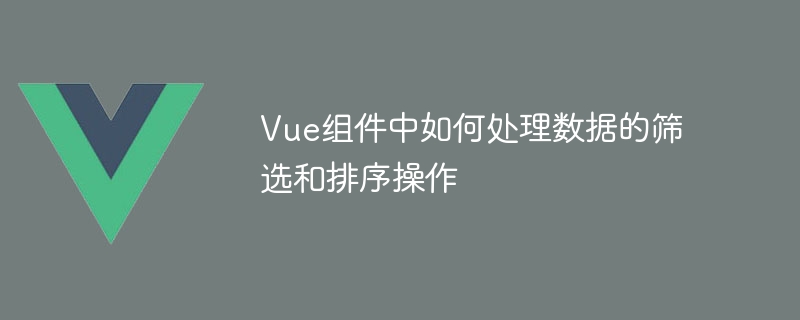

How to handle data filtering and sorting operations in Vue components requires specific code examples
In Vue.js development, it is often necessary to filter and sort data. . These operations can be implemented through computed properties and methods of Vue components. This article will introduce how to use Vue components to handle filtering and sorting of data, and provide specific code examples.
Filtering operation
A common requirement is to filter out qualified data based on certain conditions. For example, we have a list of students and need to filter out students who are 18 years or older. The following is a code example that uses Vue components to implement filtering operations:
<template>
<div>
<input v-model="filter" placeholder="请输入年龄筛选条件" />
<ul>
<li v-for="student in filteredStudents" :key="student.id">{{ student.name }},{{ student.age }}岁</li>
</ul>
</div>
</template>
<script>
export default {
data() {
return {
students: [
{ id: 1, name: '张三', age: 18 },
{ id: 2, name: '李四', age: 20 },
{ id: 3, name: '王五', age: 22 },
{ id: 4, name: '赵六', age: 16 },
],
filter: '',
};
},
computed: {
filteredStudents() {
return this.students.filter((student) => {
return student.age >= 18;
});
},
},
};
</script>In the above code, we define a data attribute students, which stores the student list data. By using the v-for directive, the student list can be rendered in a loop. In the input box, we use the v-model directive to bind the input filter conditions to the filter attribute.
By using the filter method in the calculated attribute filteredStudents, you can filter out the student data that meets the conditions based on the condition that the age is greater than or equal to 18 years old, and then in the template Render it out.
Sort operation
In addition to filtering operations, sorting operations are also common requirements. For example, we have a list of products and need to sort the products from low to high based on price. The following is a code example that uses Vue components to implement sorting operations:
<template>
<div>
<button @click="sortAsc">按价格从低到高排序</button>
<ul>
<li v-for="product in sortedProducts" :key="product.id">{{ product.name }},{{ product.price }}元</li>
</ul>
</div>
</template>
<script>
export default {
data() {
return {
products: [
{ id: 1, name: '商品1', price: 100 },
{ id: 2, name: '商品2', price: 50 },
{ id: 3, name: '商品3', price: 200 },
{ id: 4, name: '商品4', price: 80 },
],
};
},
methods: {
sortAsc() {
this.products.sort((a, b) => {
return a.price - b.price;
});
},
},
computed: {
sortedProducts() {
return this.products;
},
},
};
</script>In the above code, we define a data attribute products, which stores the product list data. By using the v-for directive, the product list can be rendered in a loop. When the "Sort by price from low to high" button is clicked, the sortAsc method is called to sort the product list. In the method, we use the sort method to pass in a sorting function to sort the items according to their price.
In the calculated attribute sortedProducts, we directly return products, so that when the sorting of the product list changes, the list in the template will also be automatically updated.
Summary
Through the calculated properties and methods of Vue components, we can easily implement filtering and sorting operations on data. In the filtering operation, the data is filtered using the filter method, and data that meets the conditions is rendered in the template. In the sort operation, the data is sorted by using the sort method, and the sorted data is rendered into the template. The above code example shows how to handle data filtering and sorting operations in the Vue component. I hope it will be helpful to you.
The above is the detailed content of How to handle data filtering and sorting operations in Vue components. For more information, please follow other related articles on the PHP Chinese website!




